Credit Momentum Report
What is credit momentum?
One indicator of more equitable and higher college completion rates is referred to in the literature as credit momentum.
According to Attewell and Monaghan (2016) and Belfield, Jenkins, and Lahr (2016), momentum is defined as attempting at least 15 credits in the first term. These studies find that students with momentum have higher graduation rates, and that the effect is especially strong for students of color.
We investigated whether the same is true at CSUN.
We explored the outcomes among full-time students who attempted at least 15 units in the first term and among those who attempted at least 30 units in the first year and found results consistent with the previous research. In addition to looking at differences in 4- and 6-year graduation rates between first time, full-time freshmen who attempted at least 30 units in their first year (momentum students) and those who attempted fewer than 30 units (non-momentum students), we also explored whether there were differences between the two groups in one-year retention rates, unit accumulation at the end of each year, and average GPA at the end of each year.
Who Are Momentum Students?
To compare the outcomes for momentum and non-momentum students, we analyzed data from the 2007 and 2008 cohorts of first-time freshmen enrolled full-time.
We began by comparing the demographic characteristics of momentum and non-momentum students and found that they are similar enough to compare.
Among racial and ethnic groups, African American, Asian American, and Latinx students are slightly less likely to take at least 30 units in their first year. White students, on the other hand, are slightly more likely to take at least 30 units in their first year.
With regard to income and parent education, Pell eligible students are slightly more likely to take at least 30 units in their first year and first generation students are slightly less likely to take at least 30 units in their first year.
Notably, momentum and non-momentum students start college with nearly identical high school GPAs.
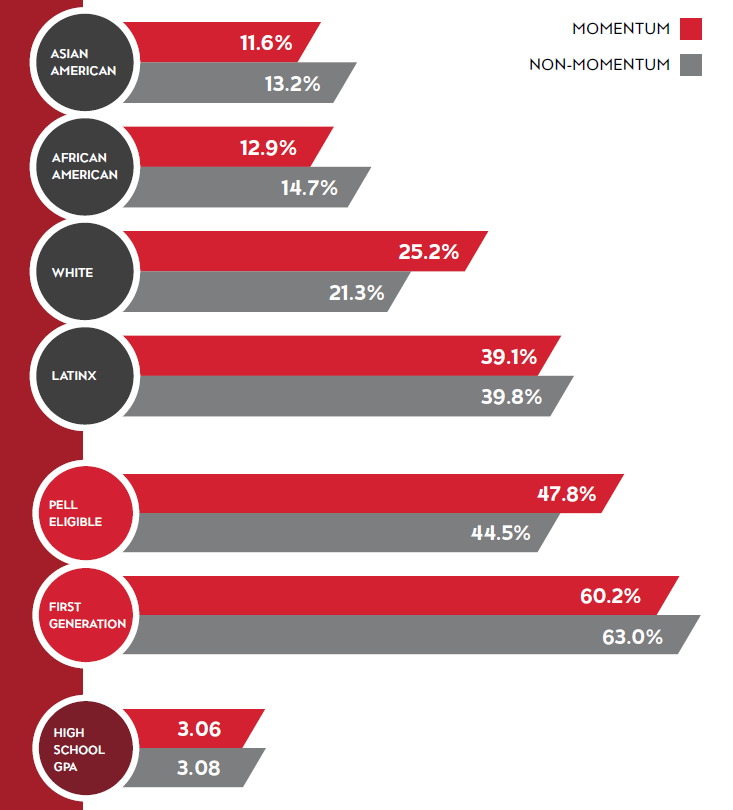
Results
The results are consistent with the findings in the literature on credit momentum.
At CSUN, first-time, full-time freshmen in the 2007 and 2008 cohorts who attempted at least 30 units in the first year had higher 4- and 6-year graduation rates than full-time students who attempted fewer than 30 units. Additionally, momentum students were more likely to return for a second year, had higher average GPAs at the end of each year, and had accumulated more units at the end of each year than non-momentum students.
Graduation Rates
Graduation rates were considerably higher for momentum students than for non-momentum students across all racial groups.
Overall, the 6-year graduation rate was 30% higher among momentum students than non-momentum students, with 57.2% of the former graduating in 6 years, compared with 43.8% of the latter graduating in 6 years. This is a difference of approximately 1,100 students.
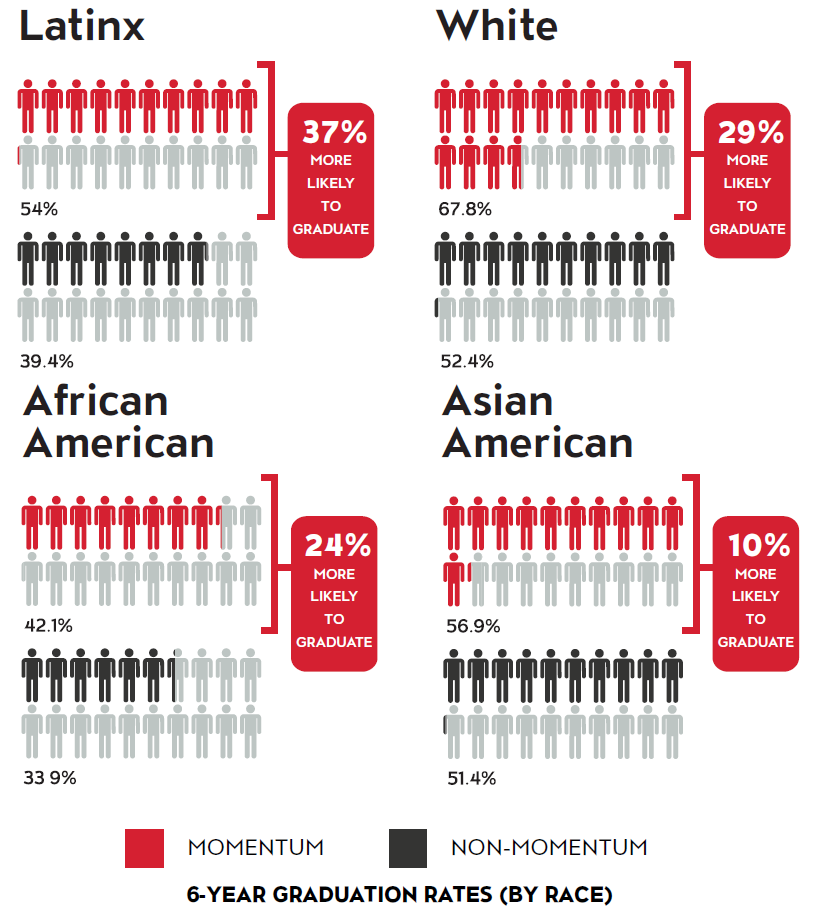

The 4-year graduation rate among momentum students was 22.3%, compared with 8.6% among non-momentum students.
In other words, momentum students were nearly 3 times as likely to graduate in 4 years than non-momentum students.
This increase is largely driven by the higher 4-year graduation rates of White and Asian American momentum students.
Among Latinx and African American students, the differences in 4-year graduation rates between momentum and non-momentum students were less dramatic.
Retention Rates
In addition to graduation rates, we also compared one-year retention rates between momentum students and non-momentum students.
First-time freshmen who attempted at least 30 units in their first year were 14% more likely to return for a second year than those who attempted fewer than 30 units.
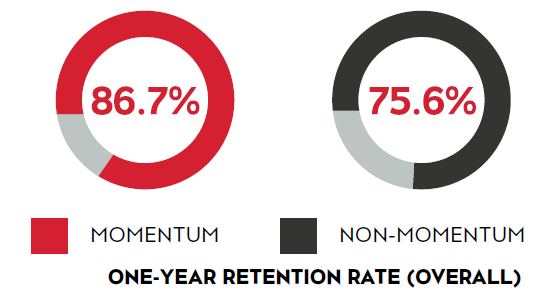
The retention benefit of credit momentum holds up across racial groups as well, with the largest benefit occurring for African American first-time freshmen.
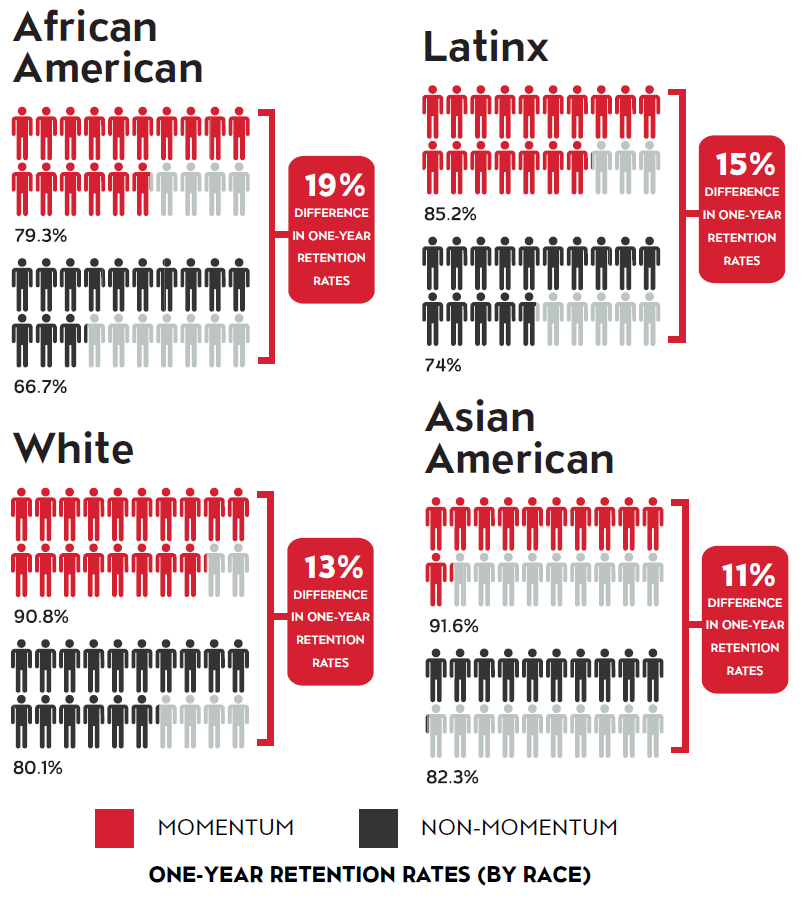
Race Gaps in One-Year Retention Rates
While we see increases in one year retention rates across all groups, it is worth highlighting that that gap in retention rates between African American and White students is slightly narrower among momentum students than among non-momentum students.

GPA
Momentum students also have higher GPAs at the end of each year, although the difference between momentum and non-momentum students in this regard decreases over time.
Although momentum (3.06) and non-momentum students (3.08) start college with almost identical high school GPAs, by the end of the first year, momentum students have a higher cumulative GPA by a third of a letter grade than non-momentum students.
At the end of the first year, momentum students have a B- average, whereas non-momentum students have a C+ average. By the end of the fourth year, both momentum and non-momentum students have a B- average, but the momentum students’ grade point average is slightly higher. This is true across racial groups.
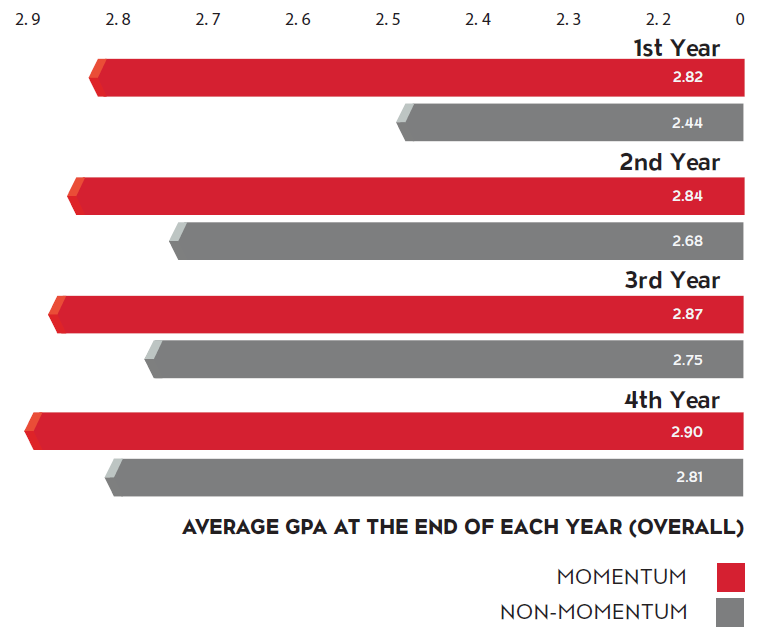

Unit Accumulation

Students who attempt at least 30 units in their first year accumulate more units each year than students who attempt fewer than 30 units.
By the end of the second year, momentum students had successfully completed about 56 units, compared with non-momentum students who had completed about 49 units.
By the end of the fourth year, momentum students had accumulated 108 units, compared with about 100 units accumulated by non-momentum students.
In other words, students who attempt at least 30 units in their first year go on to successfully complete more units than students who start out taking fewer units.
References
Attewell, P., & Monaghan, D. (2016). How many credits should an undergraduate take? Research in Higher Education, 57(6), 682-713.
Belfield, C., Jenkins, D., & Lahr, H. (2016, unpublished). Momentum: The academic and economic value of a 15-credit first-semester course load for college students in Tennessee.